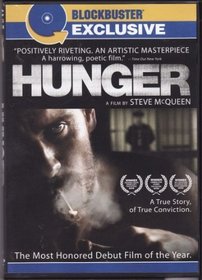Corporal Descent, Spiritual Ascent: A Triptych
Grady Harp | Los Angeles, CA United States | 07/05/2010
(5 out of 5 stars)
"HUNGER is a work of art - in more ways than one. It resembles to power of the majestic murals and altarpieces created for the medieval cathedrals, art that depicted worldly suffering and bitter realities that eventually promised something better in the future - after death. The film, based on a true event in Ireland of 1981 - the hunger strike and subsequent death of Bobby Sands who believed the only way to make the British government understand the political commitment of the IRA - and it is painted by British artist/writer/director Steve McQueen as a vast triptych. The first 'panel' depicts the incarceration in the filth of the H-Block in the Maze prison in Belfast: the silent 'narrator' is prison guard Raymond Lohan (Stuart Graham) who we meet as he dresses for work, bathing his knuckles bruised by the beatings of the prisoners he controls. A new character is introduced into the painting as recently arrested IRA member Davey Gillen (Brian Mulligan) who in keeping with the philosophy of his fellow prisoners refuses the prison uniform, opting to be naked and is through into a fecal smeared cell with Gerry Campbell (Liam McMahon). We follow these two as they breakdown after protesting the living conditions and the beatings of the guards, and a plan for revenge is made. In a poignant scene we see Lohan visiting his demented mother in a nursing home and during Lohan's attempts to share love with his mother an IRA hitman enters and murders him. The fuse for the repercussions is set.
The middle panel of this triptych is where we meet Bobby Sands (Michael Fassbender), shorn of his hair and brutally beaten, in conversation with an old friend, Father Dominic Moran, who came form the same background as Bobby but has been summoned for reasons not immediately explained. This middle panel of the triptych is static in that it is restricted to the two men at a table in the prison, smoking, and interchanging memories and conversation. In this dialogue we learn the reasons for the long lasting political animosity within Ireland - better than any movie so far - as it is at this point that Bobby informs Father Moran that he will be the first of 75 prisoners to go on a hunger strike. Despite Father Moran's attempts to show Bobby how futile his concept is, Bobby believes so firmly in his issues that he refuses to abandon his plan, knowing that he will die if the government doesn't respond to the prisoners' demands. (This portion of the screenplay was written by the playwright Edna Walsh and it is brilliantly terse, compact, and emotionally devastating.)
The final panel of the triptych is the gradual, almost silent deterioration of Bobby Sands as he spends the last 66 days of his life refusing all food, growing nearly flaccid from his loss of boy mass, covered with decubitus ulcers, and finally dying. It is a tragic third of the film and one that is so compelling that the viewer almost forgets to breathe. The manner in which the body of Bobby Sands is cared for is not unlike the tomb of Gethsemane, agonizingly quiet, gentle, and finally ending with a view of the Ireland outside the prison walls with birds flying off in the distance.
Throughout this intense drama there are moments supplied by Director McQueen that share the human side of both ends of the political/prisoner spectrum: during one of the most brutal beating scenes while the guards are in riot gear flailing the prisoners with clubs, we see in a hidden corner one of the prison guards hiding from the mêlée, crying. And there are moments of conversation between some of the prisoners and their families that are deeply touching. Michael Fassbinder gives an extraordinary performance as Bobby Sands: to make his hunger strike credible the actor lost weight to the point of emaciation, and yet this physical portion of his role, appalling though it is, does not compare to the nonverbal language of his face while he ends his life. This is a magnificent piece of filmmaking and one that should be shared by everyone who wonders about the history of modern politics in Ireland. Grady Harp, July 10"


















